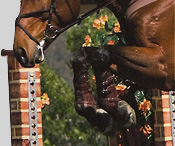



Late Gestation Mare Care
and the Foaling Process

Late Gestation Mare Care
Pregnant mares should be vaccinated 4-6 weeks before foaling. This vaccination is critical, and is protecting the foal as well as the mare. The antibodies created in response to this vaccination will be concentrated in the mare's colostrum, which is the milk she produces at foaling time. The foal has specialized cells in the small intestinal lining that are able to absorb the large antibody molecules present in colostrum. These cells only function for the first 24 hours of life, therefore it is essential that the foal consume adequate high quality colostrum during this period. This process is called Passive Transfer of Immunoglobulin. If your mare should begin dripping colostrum prior to foaling, DO NOT milk her out, as this will increase colostral loss. Foals born to mares that loose significant colostrum pre-foaling are at greater risk of inadequate antibody transfer.
In northern Nevada, I recommend the following pre-foaling vaccines: Tetanus, Eastern & Western Encephalitis, West Nile virus, Influenza, and Rhinopneumonitis. Additional vaccines that may be considered include Rabies and Strangles, based on individual environmental circumstances.
Your mare should have received Pneumabort K vaccinations at 5, 7 and 9 months of pregnancy to protect against the Equine Herpes Virus that can cause late term abortion. She also should have been on a regular deworming schedule throughout her gestation. Her last pre-foaling deworming (with Ivermectin) should be given at the same time as her pre-foaling vaccinations (4-6 weeks before her due date). It is also a good idea to deworm the mare with double dose pyrantel pamoate (Strongid) 24-48 hours after she delivers, as there is a natural rise in parasite egg elimination immediately after giving birth that can lead to an early parasite burden in the foal.
The Foaling Process
Most mares foal without difficulty, and are best left alone to foal unassisted as you watch quietly from outside the stall to avoid stress to the mare. Unfortunately when things do go wrong it usually happens rapidly and often with serious consequences to both mare and foal. The best preparation for the abnormal is to know the normal. Following are the normal stages of labor, with notations when to take action and call your veterinarian.
First Stage Labor
The mare has some control over first stage labor and can reverse the birth process at this point if she feels stressed or uncomfortable in her environment. Signs of normal first stage labor include restlessness, circling in the stall, lying down and getting up, but no signs of obvious strong contractions. Depending on the mare, signs of first stage labor may be seen intermittently for several days. If there is any doubt in your mind whether you are observing first stage labor or signs of colic or true distress, don't hesitate to call to discuss your observations.
Second Stage Labor
Second stage labor involves the actual delivery of the foal. In the horse this is a rapid event. Once the mare is exhibiting strong contractions and her water has broken, the foal should be on the ground within 30 minutes. In a normal delivery, you will see two front feet, one slightly ahead of the other, followed by the foal's nose, head and neck. The mare may get up and down several times during second stage labor, and will appear quite distressed, even in normal delivery. Some mares will deliver their foal standing, although this is not common.
If more than 20 minutes pass after the onset of strong contractions and the foal has not been delivered, CALL THE VET.
If you see anything other than two feet and a head as the foal appears, CALL THE VET.
Third Stage Labor
Third stage labor involves passage of the after birth. During this period the foal will be struggling to rise, standing, and making initial attempts to nurse. The mare may show signs of abdominal cramping as her uterus begins the rapid process of contracting to expel the placenta. The placenta should be passed within two hours of the foal's birth. Save the placenta in a bucket covered with water so that it can be examined during the foals' well-check exam.
If the placenta is not passed within 2 hours of delivery, CALL THE VET.
The Newborn Foal
A normal newborn foal will make an attempt to roll into a sternal position and shake its head almost immediately upon delivery. Initial attempts to stand should begin within 10 minutes and the foal should be standing within 30 minutes.
If the foal is not standing within 30 minutes, CALL THE VET.
The normal foal will be nursing within 2 hours, and some begin much sooner.
If the foal is not nursing within 2 hours of delivery, CALL THE VET.
These fundamental rules are set in stone. Look at your watch when your mare goes into second stage labor (full contractions and delivery) and keep track of events for the next several hours.
Assuming your foal is delivered without complication, you should dip the umbilical cord in dilute chlorhexidine or 2% iodine within 30 minutes of birth. Do not cut or tie the umbilical cord, rather allow it to break on its own. When the placenta passes, collect it and save it in a bucket. Once the foal is up and nursing by 2 hours, give everyone a hug and a smile, and call Dr. Collatos and schedule a newborn foal exam to be performed when the foal is 18-24 hours old. At this age a blood test will be performed to ensure that the foal has adequate IgG (antibody), a full physical examination of the mare and foal will be performed, and the placenta will be inspected to be sure it is intact.
Essentials for Delivery
* Laminated card fixed on foaling stall with important phone numbers
* Clock with a second hand mounted outside foaling stall in clear view.
* Clipboard with pen attatched hanging outside foaling stall.
* Tail wrap for mare
* Plenty of dry towels
* Dilute chlorhexidine or 2% iodine to dip umbilicus
* Clean bucket, Warm water, Ivory soap and KY jelly
PO BOX 60730
RENO NV 89506
EMERGENCY (775) 742-2823 OFFICE (775) 969-3495
FAX (775) 969-3923





